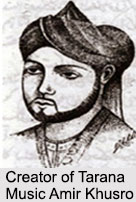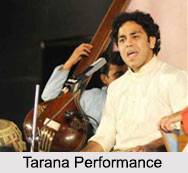 Tarana is a classical music form, sung to fast the tempo (generally in the later) by using words and vocals like - "ta", "nom", "na", "da", "re", "odani", "tanom", "yalali" and "yalalom". Rhythmic words used in Pakhawaj, tabla like "dha", "tir kit tak", sitar bols such as "dirdir tom" and "sargams" are used to craft a composition in a raaga. Tarana wholly relies on rhythmically set `meaningless` bols to develop a raaga. "Khayalnuma" is an alternative of the "Tarana", which is performed with a relaxed hustle.
Tarana is a classical music form, sung to fast the tempo (generally in the later) by using words and vocals like - "ta", "nom", "na", "da", "re", "odani", "tanom", "yalali" and "yalalom". Rhythmic words used in Pakhawaj, tabla like "dha", "tir kit tak", sitar bols such as "dirdir tom" and "sargams" are used to craft a composition in a raaga. Tarana wholly relies on rhythmically set `meaningless` bols to develop a raaga. "Khayalnuma" is an alternative of the "Tarana", which is performed with a relaxed hustle.
History of Tarana
There are a few uncertain stories and some possibilities offered to describe the origin of Tarana. According to one story, Tarana is known to have evolved from the enduring and earnest efforts of the legend himself, Amir Khusro. Khusro himself has credited to have initiated several other Hindustani classical musical forms, and tarana is always counted under it. Another version of the same story adds that Khusro added elements of Sufi mystical poetry to the bols.
Ustad Amir Khan sincerely believed in the Persian origins of Tarana and combined the Persian couplets with a mystical aim into the bols. Whether the claim is true or not, his tarana versions have the rare sheen that comes from the distinguishing incorporation of the right bols and apt couplets that further animate the sparkling mood he creates. Tarana relies solely on rhythm, tabla bols and it tries to maintain a balanced pattern. It can thus be understood that the tempo or laya is bound to be fast and not slow like khayal bandishes. 
Composition of Tarana
The structure of Tarana consists of a core melody, typically short, frequent many times, with the difference and elaboration by the side of the performer`s caution. There is a second, complementary melody, usually with higher notes, which is introduced once before returning to the main melody. The tarana may consist of a Persian rhyme and may use syllables from sitar. Singers might perform full compositions within the body of the tarana. Tarana compositions have regularly been used in all together presentations featuring Carnatic and Hindustani musicians.
Famous Singers of Tarana
Pt. Krishnarao Pandit, Ustad Nissar Hussain Khan and Ustad Amir Khan have been some of the greatest singers of tarana in the 20th century. Other contemporary singers like Malini Rajurkar, Veena Sahasrabuddhe, Ulhas Kashalkar and Padma Talwalkar have made Tarana a part of their concert inventory and give excellent renditions. Several singers and many gharanas have readily adopted this form as part of their repertoire. However, the singers of the Rampur-Sahaswan gharana possess a special ability to sing spirited and beautifully patterned taranas, as clearly evidenced by its finest contemporary exponent, Rashid Khan.
Tarana is found all over India. It is a kind of singing is exclusive in its own way. It is based upon the use of hollow syllables in a very fast performance.




















